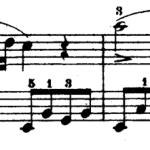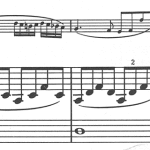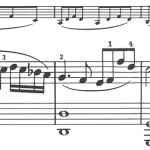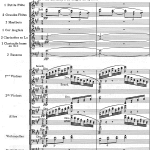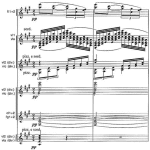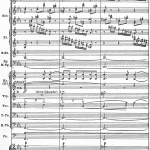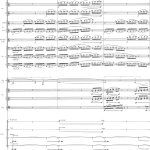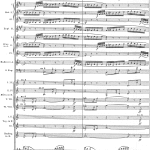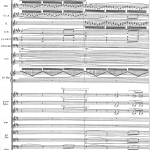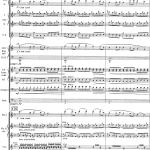Melody with accompaniment is ubiquitous as a fundamental structure in Western music after 1600. In its basic form, an accompaniment represents the harmonic background for a melody, most often by setting chords or chord progressions in motion in various ways, i.e. by “activating” the harmonic foundation, rather than by “passively” presenting a static chord. The best known classical version of such an “active harmony” is the so-called “Alberti bass,” named after the pre-classical Italian composer Domenico Alberti: chords are set in motion by means of standard figurations in the context of tonal functional harmony.
Figure 72 · Mozart, Piano Sonata K. 545, “Sonata facile,” m. 1
In terms of sonority and register, the accompaniment below – written nearly 150 years later – is far more full-bodied, but otherwise follows precisely the same model: a texture made up of repeated broken chords. And although the literature contains an abundance of textures like the ones outlined above, one must time and again admire the inexhaustible imagination with which composers throughout the history of music have refined, extended and varied this basic idea of “activating” the harmonic background.
Figure 73 · Ravel, Une barque sur l´océan, m. 1
The Alberti-model is idiomatically associated with keyboard instruments and tends to be somewhat awkward in other musical contexts. Beethoven’s so-called “Spring Sonata” demonstrates the point: the violin opens by presenting the main theme accompanied by an Alberti bass in the piano. When the two instruments swap places and the violin takes over the figuration, it becomes clear that the constant need to change strings in bowed legato (lacking the piano’s sustain pedal) results in a somewhat intrusive and clumsy version of the accompaniment figure.
Figure 74 · Beethoven, Violin Sonata op. 24 No. 5, m. 1
Figure 75 · Beethoven, Violin Sonata op. 24 No. 5, m. 11
This is presumably why the Alberti bass in its conventional form is rarely found in music for orchestra. But the basic idea – harmony set in motion by means of figuration – is fundamental to all tonal accompaniments, as evidenced by figure 30 and figure 31, cited previously. These examples further demonstrate that if an accompaniment is to accomplish its intended function as a background or backdrop for the melody (or melodies), it is of vital importance how the figuration relates to the other musical elements with regard to shape, register, sound and balance.
The opening of Brahms’ 4th symphony (figure 58) splits broken chords between violas and cellos, while the harmonic foundation is underlined by double bass and especially horn, with an effect reminiscent of the piano’s sustain pedal (see Reverberation, Echo, Resonance and Acoustic Reflection). In Ravel’s own orchestration of the piano piece cited in figure 73, the broken chords in the left hand are transformed into a tightly knit and extremely sonorous orchestral texture:
Figure 76 · Ravel, Une barque sur l´océan, m. 1
Figure 77 · Ravel, Une Barque sur l´océan, m. 1, reduction
The reduction shows that the melodic segment in the right hand remains unchanged (played by two flutes), while the chordal figuration is shaped like two independent waves, the sustain pedal (implied in the piano version) represented by long notes in the winds and tremolo in the strings.
The late romantic era, and particularly the 20th century, expanded considerably upon the paradigm of melody versus accompaniment, resulting in a wealth of new ways and methods to manipulate the perception of foreground and background in the soundscape. Yet the basic model remained true to its origins: a backdrop of harmony and timbre, against which melodic elements or other characteristic pieces of “stage scenery” emerge to create a sensation of perspective and depth. Most often, such backgrounds are distinguished by muted or discreet sonorities, low-level harmonic or rhythmic activity and figurations designed to avoid renewed attention (including repetitions, trills, ascending or descending scales, etc.) Furthermore, this type of musical background typically appears in the same general frequency range as the foreground, simply because a discernible difference in register would incur the risk of unnecessarily highlighting the background. But such considerations must be understood in the most general terms: a host of examples shows that the perception of foreground and background can be controlled in many different ways and by widely different means, and that “background” is not always a matter of simply toning down the dynamics (cf. the Ruders example, figure 79). A clearly defined hierarchy between several simultaneous musical elements tends to enhance the sensation of spatial perspective without disturbing the perceived relationship between foreground and background.
Figure 78 · Strauss, Ein Heldenleben, number 72
Here Strauss allocates the melody to trombones, cellos and double basses, joined by a counter-melody in the trumpet. Thanks to the split staccato figuration in the woodwinds, this background segment does not dominate dynamically and provides a perfect backdrop to the passage.
Figure 79 · Ruders, Symphony No. 1, 3rd movement, number 4, m. 7
In the third movement of Poul Ruders’ 1st symphony, titled Himmelhoch jauchzend, zum Tode betrübt, the horns play a continuously ascending legato melody in unison, accompanied by a shrill and high-pitched counter-element in the violins. The remainder of the orchestra contributes with a busy accompaniment of trivial scale-patterns that, despite their relative volume, are perceived as background simply because of their deliberate anonymity.
Below further examples that successfully establish a strong sensation of foreground versus background.
Figure 80 · Wagner, Walkürenritt, p. 427 (Eulenburg)
Figure 81 · Ravel, Daphnis et Chloé, number 156, m. 4
Figure 82 · Stravinsky, Petrushka, number176
· · ·
Continue · Part 2 (Chapter 5. Foreground and Background)
